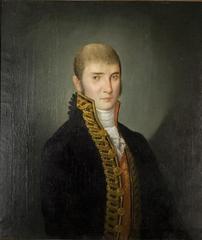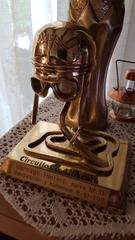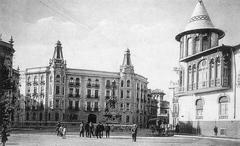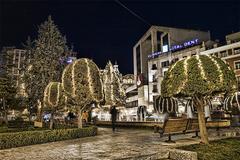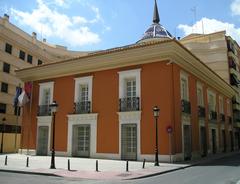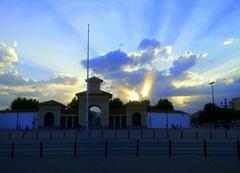Complete Guide to Visiting Museo Municipal de la Cuchillería, Albacete, Spain
Published Date: 23/07/2024
Introduction to the Museum
Welcome to the Museo Municipal de la Cuchillería in Albacete, Spain—a unique cultural institution that celebrates the city’s centuries-old tradition of cutlery craftsmanship. Established on May 6, 2004, in the historic Casa de Hortelano, the museum stands as a testament to Albacete’s rich heritage in knife-making, scissors, and other cutting tools, with its roots tracing back to the 16th century (Museo Municipal de la Cuchillería). The Casa de Hortelano, an architectural gem designed by Daniel Rubio in the early 20th century, provides an authentic backdrop for the museum’s extensive collection of over 5,000 pieces, ranging from prehistoric tools to contemporary cutlery. This guide aims to equip you with all the essential information for a memorable visit, including the museum’s history, exhibits, visitor information, and nearby attractions. Whether you’re a history enthusiast, a lover of fine craftsmanship, or simply looking for an enriching cultural experience, the Museo Municipal de la Cuchillería offers something for everyone.
Contents Overview
- Introduction
- History of Museo Municipal de la Cuchillería, Albacete
- Origins and Establishment
- Historical Significance of Cutlery in Albacete
- Key Historical Exhibits
- The Role of the Cutlery Guild
- Notable Artisans and Their Contributions
- Educational and Cultural Impact
- Recognition and Awards
- Future Prospects
- Visitor Information
- Visiting Hours
- Ticket Prices
- Guided Tours and Special Events
- Nearby Attractions
- Travel Tips and Accessibility
- Interactive Map and Virtual Tour
- FAQ
- Conclusion
History of Museo Municipal de la Cuchillería, Albacete
Origins and Establishment
The Museo Municipal de la Cuchillería in Albacete, Spain, is a testament to the city’s rich tradition in cutlery craftsmanship. The museum was inaugurated on May 6, 2004, in the historic Casa de Hortelano, a building that dates back to the early 20th century. The Casa de Hortelano itself is an architectural gem, designed by Daniel Rubio, a prominent architect of the time. The building’s restoration and adaptation for the museum were meticulously carried out to preserve its historical essence while making it suitable for modern exhibitions.
Historical Significance of Cutlery in Albacete
Albacete has been synonymous with cutlery for centuries. The city’s cutlery industry dates back to the 16th century, with the first documented evidence of knife-making in the region appearing in 1526. Over the years, Albacete’s artisans have honed their skills, making the city a renowned center for high-quality knives, scissors, and other cutting tools. The museum serves as a repository of this rich heritage, showcasing the evolution of cutlery from its rudimentary beginnings to the sophisticated craftsmanship of today.
Key Historical Exhibits
The museum’s collection is vast and varied, encompassing over 5,000 pieces that illustrate the development of cutlery through different historical periods. Some of the key exhibits include:
- Prehistoric Tools: The museum houses a collection of prehistoric cutting tools, providing insight into early human ingenuity in crafting tools for survival.
- Medieval Knives: These exhibits highlight the craftsmanship of the Middle Ages, showcasing knives that were not only functional but also ornately decorated.
- Renaissance and Baroque Periods: The cutlery from these periods reflects the artistic and cultural influences of the time, with intricate designs and the use of precious materials.
- Modern and Contemporary Pieces: The museum also features contemporary cutlery, demonstrating the advancements in materials and techniques that have shaped modern knife-making.
The Role of the Cutlery Guild
The Cutlery Guild of Albacete, established in the 18th century, played a crucial role in the development and regulation of the cutlery industry. The guild set standards for quality and craftsmanship, ensuring that Albacete’s cutlery maintained its reputation for excellence. The museum dedicates a section to the history and contributions of the guild, showcasing documents, tools, and artifacts that highlight its influence.
Notable Artisans and Their Contributions
The museum pays homage to several notable artisans who have left an indelible mark on the cutlery industry. Among them is Juan de la Torre, a master craftsman from the 17th century, whose works are considered masterpieces of cutlery art. Another prominent figure is José Luis García, a contemporary artisan known for his innovative designs and techniques. The museum’s exhibits include works by these and other artisans, providing visitors with a comprehensive understanding of the skill and creativity involved in cutlery making.
Educational and Cultural Impact
Since its opening, the Museo Municipal de la Cuchillería has become a cultural and educational hub in Albacete. The museum offers a range of educational programs, workshops, and guided tours aimed at promoting the history and art of cutlery making. These initiatives have helped to preserve traditional techniques and inspire new generations of artisans. The museum also collaborates with local schools and universities, integrating its resources into educational curricula to enhance students’ understanding of the region’s cultural heritage.
Recognition and Awards
The museum’s efforts in preserving and promoting the history of cutlery have been widely recognized. In 2010, the Museo Municipal de la Cuchillería received the prestigious “Best Museum of the Year” award from the Spanish Association of Museums. This accolade reflects the museum’s commitment to excellence in curation, education, and community engagement.
Future Prospects
Looking ahead, the Museo Municipal de la Cuchillería aims to expand its collection and enhance its exhibitions through the acquisition of new pieces and the incorporation of interactive technologies. The museum also plans to strengthen its international collaborations, hosting temporary exhibitions and cultural exchanges with other renowned museums worldwide. These initiatives will ensure that the museum continues to be a dynamic and evolving institution, preserving the legacy of Albacete’s cutlery industry for future generations.
Visitor Information
Visiting Hours
The museum is open from 10:00 AM to 2:00 PM and from 5:00 PM to 8:00 PM, Tuesday through Saturday. On Sundays and holidays, it operates from 10:00 AM to 2:00 PM. It is closed on Mondays. It’s advisable to check the official website for any changes in the schedule.
Ticket Prices
Tickets are priced at €3 for general admission and €1.50 for reduced admission (students, seniors, and groups). Admission is free on Sundays.
Guided Tours and Special Events
The museum offers guided tours at 11:00 AM and 6:00 PM from Tuesday to Saturday. Special events are held throughout the year, including knife-making workshops and cultural exhibitions. Check the museum’s website for the latest events and schedules.
Nearby Attractions
While in Albacete, don’t miss other historical sites such as the Albacete Cathedral, the Passage of Lodares, and the Botanical Garden of Castilla-La Mancha. These sites offer a deeper dive into the city’s rich history and culture.
Travel Tips and Accessibility
The museum is easily accessible by public transport, with several bus lines stopping nearby. It is also a short walk from the city center. For those driving, there are parking facilities in the vicinity. The museum is wheelchair accessible and offers facilities for visitors with disabilities.
Interactive Map and Virtual Tour
Explore the museum virtually through our interactive map available on the official website.
FAQ
What are the opening hours of the Museo Municipal de la Cuchillería?
The museum is open from 10:00 AM to 2:00 PM and from 5:00 PM to 8:00 PM, Tuesday through Saturday. On Sundays and holidays, it operates from 10:00 AM to 2:00 PM. It is closed on Mondays.
How much are tickets?
Tickets cost €3 for general admission and €1.50 for reduced admission (students, seniors, and groups). Admission is free on Sundays.
Are guided tours available?
Yes, guided tours are available at 11:00 AM and 6:00 PM from Tuesday to Saturday.
Is the museum accessible for wheelchair users?
Yes, the museum is fully wheelchair accessible.
Can I take photos inside the museum?
Yes, photography is allowed, but using flash is prohibited to protect the artifacts.
Conclusion
The Museo Municipal de la Cuchillería is more than just a museum; it’s a journey through the rich history of cutlery craftsmanship in Albacete. From its origins in the 16th century to modern-day innovations, the museum encapsulates the essence of Albacete’s cutlery industry through its diverse exhibits and educational programs. Recognized for its excellence in curation and community engagement, the museum continues to evolve, aiming to expand its collection and enhance its exhibitions through new acquisitions and interactive technologies (Explore the Exhibits and Collections). As you plan your visit, make sure to explore the nearby attractions in Albacete, such as the Albacete Cathedral and the Passage of Lodares, to fully immerse yourself in the city’s rich cultural and historical heritage. For more information and updates, visit the museum’s official website.
Citations and Resources
- Museo Municipal de la Cuchillería, 2023, Discovering the Museo Municipal de la Cuchillería in Albacete - History, Visiting Hours, and More source url
- Museo Municipal de la Cuchillería, 2023, Explore the Exhibits and Collections at Museo Municipal de la Cuchillería - Albacete’s Historical Gem source url
- Museo Municipal de la Cuchillería, 2023, Guide to Visiting Museo Municipal de la Cuchillería - Hours, Tickets, and Tips in Albacete, Spain source url
